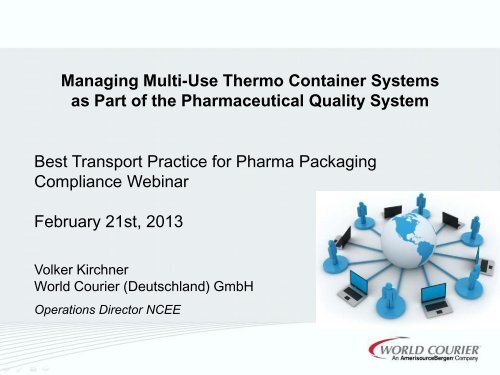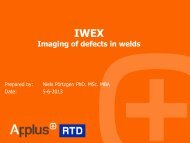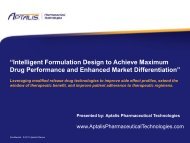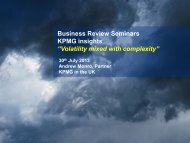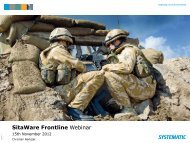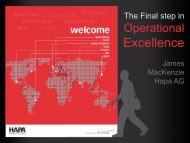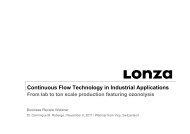Managing Multi-Use Thermo Container Systems as Part of the ...
Managing Multi-Use Thermo Container Systems as Part of the ...
Managing Multi-Use Thermo Container Systems as Part of the ...
Create successful ePaper yourself
Turn your PDF publications into a flip-book with our unique Google optimized e-Paper software.
<strong>Managing</strong> <strong>Multi</strong>-<strong>Use</strong> <strong>Thermo</strong> <strong>Container</strong> <strong>Systems</strong><br />
<strong>as</strong> <strong>Part</strong> <strong>of</strong> <strong>the</strong> Pharmaceutical Quality System<br />
Best Transport Practice for Pharma Packaging<br />
Compliance Webinar<br />
February 21st, 2013<br />
Volker Kirchner<br />
World Courier (Deutschland) GmbH<br />
Operations Director NCEE
Agenda<br />
• Active vs. p<strong>as</strong>sive packaging systems (pros and cons)<br />
• <strong>Multi</strong>-use systems (procedures / problems / solutions)<br />
• Cleaning / disinfection procedures<br />
• Maintenance<br />
• Performance control / requalification
GxP Requirements for Pharmaceutical Products<br />
Manufacturer<br />
GMP / GSP<br />
Logistics <strong>Part</strong>ners<br />
GDP / GSP<br />
Customer / Hospitals<br />
GCP / GSP
Risk Management<br />
• Force Majeure Risks: external risks can not be influenced<br />
Natural dis<strong>as</strong>ters, strikes, terrorism, wars<br />
•Climatic impact: Environment<br />
Wea<strong>the</strong>r, climate, se<strong>as</strong>on<br />
• Supply- and Process Risks:<br />
Depending on <strong>the</strong> selected <strong>the</strong>rmo container system<br />
Transportation modus (aircraft, ship, truck, train)<br />
Transit time<br />
Human- language skills. Information exchange: Qualified and trained personal<br />
Counterfeits, <strong>the</strong>ft<br />
• Demand Risks: Market / customer related
Innovative Supply Chain
Temperature Ranges<br />
-196°C - liquid nitrogen shippers / dry shippers (-180°C)<br />
-80°C - Dry ice<br />
-40°C - PCMs<br />
-20°C - Gel packs / PCMs<br />
+2° to +8°C - Gel packs / PCMs<br />
+15° to +25°C - PCMs<br />
+37°C - PCMs
Potential solutions<br />
Packaging<br />
• Active <strong>Systems</strong><br />
• Semi-active <strong>Systems</strong><br />
• P<strong>as</strong>sive <strong>Systems</strong><br />
• Single / <strong>Multi</strong>ple <strong>Use</strong><br />
7
Active <strong>Systems</strong><br />
• Respond actively to changes in temperature<br />
• Require electricity to me<strong>as</strong>ure and influence<br />
temperature<br />
• Can have moving parts (fan)<br />
• Can utilize dry ice (DG) for cooling<br />
• Usually large, multi-use units<br />
• Not highly insulated due to <strong>the</strong>ir nature<br />
• Examples: Envirotainer, reefer trucks
Example: Envirotainer / Unicooler<br />
• Active <strong>Systems</strong> - Unit Load Devices (ULD)<br />
• +2°C to +8°C<br />
• +5°C to +30°C<br />
• -20°C to +30°C<br />
• <strong>Use</strong>s dry ice to cool, operated by fans<br />
• Unicooler can additionaly heat<br />
• Reusable <strong>Systems</strong>
Active <strong>Systems</strong> - Summary<br />
Pros<br />
• For pallet commodity<br />
• No preconditioning <strong>of</strong> gel packs is necessary<br />
• Newer models have active heating <strong>as</strong> well <strong>as</strong> cooling systems<br />
Cons<br />
• Limited insulation – susceptible to external temperatures<br />
• Customs and operator restrictions<br />
• <strong>Multi</strong>-<strong>Use</strong> system need to be cleaned and maintained after each transport<br />
• Susceptible to loss <strong>of</strong> power, loss <strong>of</strong> coolant, mechanical breakdown<br />
• Not all systems are redundant
Semi-active <strong>Systems</strong><br />
• Generally single-use packaging<br />
• +2° to +8°C shipments<br />
• <strong>Use</strong> both refrigerated <strong>as</strong> well <strong>as</strong> frozen gel packs<br />
• Polystyrene or polyurethane boxes<br />
• Often used for “final-leg” transports<br />
• Can’t regulate energy rele<strong>as</strong>e<br />
• Susceptible to colder environments
Semi-active <strong>Systems</strong> - Summary<br />
Pros<br />
• Low cost<br />
• Low weight<br />
• Single use, need no cleaning and maintenance<br />
Cons<br />
• +2° to +8°C different configurations – winter / summer times<br />
• Low <strong>the</strong>rmal and physical stability
P<strong>as</strong>sive <strong>Systems</strong><br />
• Single- or multi-use packaging<br />
• Various temperature ranges<br />
• Generally use Ph<strong>as</strong>e Change Material gel packs<br />
• PCMs conditioned to product temperature<br />
• Can be e<strong>as</strong>ily stored in cooler / freezer<br />
• High degree <strong>of</strong> security and protection<br />
• Higher weight, physically robust
Example 1: Credo Cube<br />
• P<strong>as</strong>sive system<br />
• Ph<strong>as</strong>e Change Material PCM<br />
• +15°C to +25°C<br />
• +2ºC to +8ºC<br />
• -15°C to -25ºC<br />
• Hard c<strong>as</strong>e, reusable outer shell<br />
• Removable outer box<br />
• Vacuum Insulated Panels<br />
• Different sizes
Credo Cube - Summary<br />
Pros<br />
• Good cost/benefit performance<br />
• Lower weight<br />
• No state and operator restrictions<br />
• No different configurations for summer or winter<br />
Cons<br />
• Sensitive against external influences<br />
• Locking only possible for largest system<br />
• Check each system for physical stability<br />
• Block loading is not possible<br />
• Maintenance and cleaning
Example 2: VIP TCS
Pros VIP TCS <strong>Multi</strong>-use<br />
• no state- and operator restrictions<br />
• ball corners to prevent direct contact to earth surface<br />
• One configuration for summer- and winter times<br />
• Physical stability<br />
• Block loading<br />
• Tainer- and c<strong>as</strong>es are stackable for fork lifts on a<br />
permanent pallet
Cons VIP TCS <strong>Multi</strong>-use<br />
• Higher weight<br />
• VIP <strong>Multi</strong>-use are rentable systems and need to return after delivery<br />
• <strong>Multi</strong>-use units need maintaining and cleaning<br />
• Vacuum Insulation Panels between inner – and outer container are<br />
not visible
VIP PCM Types<br />
Ph<strong>as</strong>e Change Material (PCM )<br />
► High performances Ph<strong>as</strong>e Change Material with longer temp slot<br />
availability<br />
► Conditioned to same temperature <strong>as</strong> <strong>the</strong> product<br />
► Conditioning by courier’s or customer’s trained staff, according to<br />
SOP
PCM and Temp Probe Conditioning
<strong>Multi</strong>-use TCS Packaging and Labelling<br />
• Labelling<br />
• Place PCMs into unit according to SOP<br />
• Initial start <strong>of</strong> <strong>the</strong> conditioned temperature monitor<br />
• Place <strong>the</strong> conditioned product into <strong>the</strong> TCS
PCM Types in <strong>Multi</strong>-use <strong>Systems</strong><br />
Qualified transit times for transport <strong>of</strong> temp-controlled samples between (+2º to +8ºC):<br />
VIP TCS<br />
Outside<br />
Temperature<br />
Number <strong>of</strong> PCMs<br />
Qualified time<br />
VIP-box 3L<br />
+35°C (± 1°C)<br />
+20°C (± 5°C)<br />
-5° C (± 1°C)<br />
6 x 10L+04G<br />
82 h<br />
120 h<br />
59 h<br />
VIP-box XL<br />
(45L)<br />
+35°C (± 1°C)<br />
+20°C (± 5°C)<br />
-5° C (± 1°C)<br />
24 x 10L+04G<br />
93 h<br />
120 h<br />
64 h
Qualified Transit Times Credo TCS<br />
Transport <strong>of</strong> temp-controlled samples between + 2º to +8ºC<br />
• Payload capacity 56 L / 25 kg<br />
• Payload area DIMS (LxWxH)<br />
38,1 x 38,1 x 38,1 cm<br />
• Payload exterior DIMS (LxWxH)<br />
53,3 x 49,5 x 50,2 cm<br />
• Modular TIC® walls with integrated<br />
ph<strong>as</strong>e change material<br />
• Series 4 – 5696 (Credo Cube)<br />
• Thermal performance 96 hours<br />
in summer pr<strong>of</strong>ile (+22° to + 35°C)
Evaluation Temperature Monitoring
<strong>Multi</strong>-use TCS Cleaning
<strong>Multi</strong>-use Cleaning and Disinfection<br />
• <strong>Multi</strong>-use TCS need to be cleaned after each transport<br />
• Cleaning <strong>of</strong> <strong>the</strong> systems according to SOP<br />
• Disinfection <strong>of</strong> <strong>the</strong> inner – and outer containers<br />
• Using <strong>of</strong> coloured labels in order to differentiate disinfected from not<br />
disinfected units<br />
• Documentation <strong>of</strong> cleaning<br />
• Administration <strong>of</strong> <strong>the</strong> units by serial number
<strong>Multi</strong>-use Performance Control<br />
• Performance test <strong>of</strong> systems by temperature monitoring with each transport<br />
• PCM discharge control<br />
• Green label – ready to use
<strong>Multi</strong>-use TCS Requalification<br />
• Identification by serial number<br />
• Servicing in a maintenance department, if damages are visible<br />
• Continuous visible inspection for possible contamination and replacement<br />
<strong>of</strong> PCMs when necessary<br />
• Regular control <strong>of</strong> transport frequency and unit age by serial number and<br />
list examination by logistics partner or customer
Examples Using <strong>Multi</strong>-use TCS<br />
• Investigational Drugs<br />
• Medical products<br />
• Biological products and substances<br />
• Vaccines<br />
• Replacements<br />
• Clinical supplies with restrictions about <strong>the</strong> stability <strong>of</strong> <strong>the</strong> product
<strong>Multi</strong>-use <strong>Systems</strong> Protect <strong>the</strong> Environment
Quality <strong>Systems</strong><br />
• Quality Management<br />
• Environment Management<br />
• Storage Management<br />
• Transportation Management<br />
• Risk Management<br />
31
Quality Management<br />
QMS Trained staff Equipment<br />
GDP & ISO Training / testing Qualified/calibrated<br />
32
People<br />
• Education<br />
• Training<br />
• Experience<br />
• Test for Effectiveness<br />
• Recurring Training<br />
• Documentation
P # y-m-d SOP/Topics FAQ #<br />
01 09-08-01 SOP Creation, Review + Distribution<br />
02 10-01-01 Acceptance and Service Restrictions<br />
03 10-01-01 Dangerous Goods - Shipping Restrictions<br />
SOP Topics<br />
04 09-09-15 Fridges and Freezers for Pre-Conditioning <strong>of</strong> Gel Packs<br />
05 09-09-15 Preparation <strong>of</strong> Gel Packs for <strong>Use</strong><br />
06 09-09-15<br />
Selection and <strong>Use</strong> <strong>of</strong> Gel Packs within Temperature Controlled Shipment<br />
Packaging<br />
07 09-09-15 Dry Ice Information and Handling<br />
08 09-08-01 Special Handcarry<br />
09 09-08-01 Shipment Value/Currency + Weight/Dimensions<br />
10 10-05-15 Handling <strong>of</strong> T2 Envirotainers<br />
11 10-05-15 Handling <strong>of</strong> e1 Envirotainer<br />
12 09-09-15 Dry Shipper Handling<br />
13 09-11-16 GDP Compliant Documentation<br />
14 09-11-16 Premises and Equipment<br />
15 09-11-16 CAPA (Corrective And Preventive Action)<br />
16 09-11-16 Change Control Management<br />
17 09-11-16 External Audits<br />
18 09-11-30 Self Inspection<br />
19 09-11-16 Management <strong>of</strong> Outsourced Activities and Purch<strong>as</strong>ed Materials<br />
20 09-11-30 Training Program<br />
21 10-05-01<br />
KPI and Incident Reporting Monitoring Process Performance and Product<br />
Quality<br />
22 09-11-30 Management Review Meeting<br />
23 10-05-01 VIP TCS Cleaning Procedure<br />
25 10-08-01 Internal Audits<br />
30 09-09-01 Selecting and Preparing Temperature Monitors<br />
31 09-09-01<br />
32 10-05-17<br />
Starting Temperature Monitors, Positioning Monitors inside Shipments and<br />
Recording this Information<br />
Recovering Temperature Monitors, Recovering and Distributing Data,<br />
Storage <strong>of</strong> <strong>Use</strong>d Monitors<br />
032<br />
27 Computer Backups and Dis<strong>as</strong>ter Recovery - see INET MIS
Challenges <strong>of</strong> <strong>Multi</strong>-use <strong>Systems</strong><br />
Challenges <strong>of</strong> using multi-use systems can<br />
only be overcome in a strong network with well<br />
developed quality management systems and<br />
highly motivated and trained people!<br />
35
Vielen Dank!
GxP in Transportation<br />
Good Distribution Practice and Regulatory Compliance<br />
In International Biopharm Logistics<br />
37<br />
Global Webinar<br />
21 February 2013
G X P I N T R A N S P O R T A T I O N | C H A P T E R 1<br />
World Courier<br />
GxP Presentation<br />
Presentation Outline<br />
1. Why GxP?<br />
A short history <strong>of</strong> how GMP evolved<br />
2. The poor relations<br />
GSP and GDP enter <strong>the</strong> scene<br />
3. The shifting Focus<br />
Regulatory Updates<br />
4. Daily Distribution Challenges<br />
How to <strong>as</strong>k <strong>the</strong> right Questions<br />
5. Potential Solutions<br />
A Look at GxP compliant services<br />
38
G X P I N T R A N S P O R T A T I O N | C H A P T E R 1<br />
Why GxP?<br />
A short history <strong>of</strong> how<br />
GMP evolved<br />
39
G X P I N T R A N S P O R T A T I O N | C H A P T E R 1<br />
Why GxP | A short history <strong>of</strong> how GMP evolved<br />
Definitions – GxP<br />
GxP is a general term for Good Practice quality guidelines and<br />
regulations.<br />
These guidelines are used in many fields, including <strong>the</strong><br />
pharmaceutical and food industries.The titles <strong>of</strong> <strong>the</strong>se good<br />
practice guidelines usually begin with "Good" and end in "Practice",<br />
with <strong>the</strong> specific practice descriptor in between. GxP represents <strong>the</strong><br />
abbreviations <strong>of</strong> <strong>the</strong>se titles, where x (a common symbol for a<br />
variable) represents <strong>the</strong> specific descriptor.<br />
40
G X P I N T R A N S P O R T A T I O N | C H A P T E R 2<br />
The poor relations<br />
Good Practice<br />
GMP Production and Control <strong>of</strong> marketed<br />
and investigational products<br />
GSP Storage <strong>of</strong> pharmaceutical<br />
products<br />
GDP Distribution <strong>of</strong> pharmaceutical<br />
products<br />
GCP Clinical Trial Conduct<br />
41
G X P I N T R A N S P O R T A T I O N | C H A P T E R 1<br />
Why GxP | A short history <strong>of</strong> how GMP evolved<br />
Small Errors – Big Impact<br />
January 1999 | Melsungen<br />
The Company Braun Melsungen announces, that for <strong>the</strong>ir<br />
injection solution product Glucose 5 Braun (10 ml Mini-Pl<strong>as</strong>co)<br />
Charge 7344C16, PZN: 2371769, Art.-Nr.: 02354543 a few<br />
ampoules had been wrongly labelled. Those wrongly labelled<br />
ampoules contain <strong>the</strong> API (Active Pharmaceutical Ingredient)<br />
pot<strong>as</strong>sium chloride instead <strong>of</strong> glucose. The company requests<br />
to check stocks and return any existing ampoules back to <strong>the</strong><br />
producer. The recall w<strong>as</strong> initiated after two newborn babies<br />
died <strong>of</strong> heart failure in Belgium.<br />
“You cannot judge <strong>the</strong> Quality <strong>of</strong> a<br />
Pharmaceutical Product by looking at it.”<br />
42
G X P I N T R A N S P O R T A T I O N | C H A P T E R 1<br />
Why GxP | A short history <strong>of</strong> how GMP evolved<br />
Small Errors – Big Impact<br />
Contergan Scandal 1961/1962<br />
• 2.000 children dead<br />
• 10.000 children born with dysmelia<br />
(malformation <strong>of</strong> limbs)<br />
Suspected re<strong>as</strong>on for this:<br />
Pressing for market rele<strong>as</strong>e prematurely,<br />
before API had been thoroughly tested<br />
43
G X P I N T R A N S P O R T A T I O N | C H A P T E R 1<br />
Why GxP | A short history <strong>of</strong> how GMP evolved<br />
Pharmaceutical Development<br />
Cost for Research and<br />
Development <strong>of</strong> a new<br />
medicine/pharmaceutical<br />
product:<br />
1.000.000.000+ EUR<br />
Time span required from<br />
<strong>the</strong> discovery <strong>of</strong> a new API<br />
to <strong>the</strong> finished<br />
pharmaceutical product:<br />
10+ Years<br />
Chances for succes<br />
< 1%<br />
44
G X P I N T R A N S P O R T A T I O N | C H A P T E R 1<br />
Why GxP | A short history <strong>of</strong> how GMP evolved<br />
Important Dates<br />
1938 Food and Cosmetic Act (FD&C Act)<br />
1962 Kefauver-Harris Drug Amendments<br />
1968 WHO GMP Guideline<br />
1978 21CFR 210/211 and 820<br />
1983 First Guide to Computer Validation published by FDA<br />
1987 Guideline on Process Validation published by FDA<br />
1989 EC GMP-Guideline published<br />
1990 ICH Programm initiated by EC Commission<br />
1997 21CFR part 11 on electronic records and signatures<br />
ICH Q7A (GMP for producers <strong>of</strong> APIs)<br />
2005 New EC GMP Guideline published<br />
ICH Q10 („Pharmaceutical Quality System“)<br />
2008 updated cGMP Guide 21CFR 210/211<br />
45
G X P I N T R A N S P O R T A T I O N | C H A P T E R 2<br />
The poor<br />
relations<br />
GSP and GDP<br />
enter <strong>the</strong> scene<br />
46
G X P I N T R A N S P O R T A T I O N | C H A P T E R 2<br />
The poor relations<br />
What is Good Distribution<br />
Practice (GDP)<br />
“Good Distribution Practice (GDP)<br />
is that part <strong>of</strong> quality <strong>as</strong>surance<br />
which ensures that products are<br />
consistently stored, transported and<br />
handled under suitable conditions<br />
<strong>as</strong> required by <strong>the</strong> marketing<br />
authorisation (MA) 1 or product<br />
specification.”<br />
1<br />
MA w<strong>as</strong> previously known <strong>as</strong> a „product licence“<br />
47
G X P I N T R A N S P O R T A T I O N | C H A P T E R 2<br />
The poor relations<br />
From <strong>the</strong> Introduction: WHO Technical Report No. 937<br />
Annex 5 (2006) → 40 years on…<br />
meanwhile superseded by No. 957 (2010)<br />
“The quality <strong>of</strong> pharmaceutical products<br />
can be affected by a lack <strong>of</strong> adequate<br />
control over <strong>the</strong> numerous activities which<br />
occur during <strong>the</strong> distribution process.”<br />
Courier/Transport companies are <strong>the</strong>refore <strong>the</strong> (weakest?)<br />
LINK in <strong>the</strong> supply chain between Manufacturer and point <strong>of</strong><br />
dispense/use<br />
48
G X P I N T R A N S P O R T A T I O N | C H A P T E R 3<br />
Poll Question<br />
“Do you think it is<br />
necessary to<br />
qualify your<br />
transportation<br />
company and check<br />
for GxP compliance?”<br />
49
G X P I N T R A N S P O R T A T I O N | C H A P T E R 3<br />
The shifting<br />
Focus<br />
Regulatory Updates<br />
50
G X P I N T R A N S P O R T A T I O N | C H A P T E R 3<br />
The shifting Focus<br />
“Distribution is an important activity in <strong>the</strong> integrated<br />
supply-chain management <strong>of</strong> pharmaceutical products.”<br />
“The nature <strong>of</strong> risks involved is likely to be similar to that<br />
for risks encountered in <strong>the</strong> Manufacturing environment.”<br />
From <strong>the</strong> Introduction: WHO<br />
Technical Report No. 957<br />
Annex 5 (2010)<br />
“Counterfeit pharmaceutical products are a real threat to<br />
public health and safety. Consequently, it is essential to<br />
protect <strong>the</strong> pharmaceutical supply chain against <strong>the</strong><br />
penetration <strong>of</strong> such products.”<br />
“ Every activity in <strong>the</strong> distribution <strong>of</strong> pharmaceutical<br />
products should be carried out according to <strong>the</strong> principles<br />
<strong>of</strong> GMP, (…), GSP (…) and GDP (…). ”<br />
51
G X P I N T R A N S P O R T A T I O N | C H A P T E R 3<br />
The shifting Focus<br />
1. Introduction<br />
2. Scope <strong>of</strong> <strong>the</strong> document<br />
3. Glossary<br />
4. General Principles<br />
5. Regulation <strong>of</strong> <strong>the</strong> distribution<br />
<strong>of</strong> pharmaceutical products<br />
6. Organisation and<br />
Management<br />
7. Personnel<br />
8. Quality System<br />
9. Premises, Warehousing and<br />
Storage<br />
10. Vehicles and Equipment<br />
11. Shipment <strong>Container</strong>s and<br />
<strong>Container</strong> labelling<br />
12. Dispatch and Receipt<br />
13. Transportation and Products<br />
In Transit<br />
14. Documentation<br />
15. Repackaging and Relabelling<br />
16. Complaints<br />
17. Recalls<br />
18. Returned Products<br />
19. Counterfeit Pharmaceutical<br />
Products<br />
20. Importation<br />
21. Contract Activities<br />
22. Self-Inspection<br />
Annex 5 (WHO Technical Report<br />
Series No. 957, 2010)<br />
Good distribution practices for<br />
pharmaceutical products<br />
(updated from WHO Technical<br />
Report Series No. 937, 2006)<br />
52
G X P I N T R A N S P O R T A T I O N | C H A P T E R 3<br />
The shifting Focus<br />
GDP adopted by PIC/S<br />
Pharmaceutical Inspection Co-operation Scheme<br />
Globalisation with longer and more complex supply chains but also counterfeiting problems have<br />
been forcing pharmaceutical industry and inspectorates to challenge <strong>the</strong>ir current practices.<br />
As a consequence, PIC/S h<strong>as</strong> now amended its Pharmaceutical Inspection Co-operation Scheme Document<br />
defining both Good Manufacturing Practice (GMP) and Good Distribution Practice (GDP) <strong>as</strong> core are<strong>as</strong>.<br />
In <strong>the</strong> document it is now referred to Good Manufacturing and Distribution Practice (GMDP).<br />
Changing over from GDP to GMDP does mean that PIC/S will now<br />
also include GDP <strong>as</strong>pects in its co-operation, harmonisation and training activities.<br />
(February 2012)<br />
53
G X P I N T R A N S P O R T A T I O N | C H A P T E R 3<br />
The shifting Focus<br />
Regulatory Issues in <strong>the</strong> USA<br />
U.S. Pharmacopeia 1079<br />
“Good Storage and Shipping Practices”<br />
21 CFR 210/211<br />
‣“Current Good Manufacturing Practice in Manufacturing,<br />
Processing, Packing or Holding <strong>of</strong> Drugs, General”<br />
‣“cGMP for finished pharmaceuticals”<br />
21 CFR 820<br />
‣Quality System Regulations<br />
‣Subpart E: Purch<strong>as</strong>ing Controls -> Audits!<br />
54
G X P I N T R A N S P O R T A T I O N | C H A P T E R 3<br />
The shifting Focus<br />
Regulatory Framework<br />
EU > National Legislation<br />
• Directive 2001/20/EC<br />
• Directive 2003/294/EC<br />
• Directive 2005/28/EC<br />
• Decisions & Regulations<br />
• Recommendations<br />
• Ministry Decrees<br />
• AMWH (Germany)<br />
• AMBO 2009 (Austria)<br />
• Pharma Authorities<br />
55
G X P I N T R A N S P O R T A T I O N | C H A P T E R 3<br />
The shifting Focus<br />
European Changes<br />
Original GDP Guideline 94/C 63/03 (1994):<br />
Guidelines on Good Distribution Practice <strong>of</strong> Medicinal Products for Human <strong>Use</strong><br />
• General Guideline with less than 4 pages<br />
• Legal B<strong>as</strong>is: Article 10 <strong>of</strong> Council Directive 92/25/EEC (31 March 1992)<br />
Revised Draft <strong>of</strong> this Guideline published 15 July 2011<br />
• Greatly expanded<br />
• 10 Chapters, approx. 30 pages<br />
• Legal B<strong>as</strong>is: Article 84 <strong>of</strong> Directive 2001/83/EC<br />
• New Directive 2011/62/EU to fight Counterfeit Medication<br />
• Current Status: revision for PUBLIC CONSULTATION ended 31 Dec 2011<br />
56
G X P I N T R A N S P O R T A T I O N | C H A P T E R 3<br />
The shifting Focus<br />
European Changes<br />
New GDP Guideline (draft)<br />
1. Quality Management<br />
QMS/Risk Mgt/Mgt Review/Change Control<br />
2. Personnel<br />
Responsibilities/Training/Hygiene<br />
‣ Key Concept „Responsible Person“<br />
similar to <strong>the</strong> QP function in GMP (Ch. 2.5)<br />
3. Premises and Equipment<br />
Handling/e-<strong>Systems</strong>/Qualification<br />
4. Documentation<br />
Signatures/Archiving/SOPs<br />
5. Operations<br />
Storage/Separation/Destruction<br />
FEFO replaces FIFO<br />
Ireland<br />
Portugal<br />
Spain<br />
United<br />
Kingdom<br />
Belgium<br />
Ne<strong>the</strong>rlands<br />
France<br />
Denmark<br />
Germany<br />
Luxembourg<br />
Austria<br />
Malta<br />
Sweden<br />
Slovenia<br />
Czech<br />
Republic<br />
Italy<br />
Poland<br />
Hungary<br />
Finland<br />
Estonia<br />
Latvia<br />
Lithuania<br />
Slovakia<br />
Romania<br />
Bulgaria<br />
Greece<br />
Cyprus<br />
57
G X P I N T R A N S P O R T A T I O N | C H A P T E R 3<br />
The shifting Focus<br />
European Changes (continued)<br />
New GDP Guideline (draft)<br />
Finland<br />
6. Complaints, Returns, Suspected Falsified Medicinal<br />
Products and Medicinal Products Recalls<br />
Training for Incre<strong>as</strong>ed Awareness<br />
7. Contract Operations<br />
New Chapter/Qualification<br />
8. Self-Inspections<br />
New Requirement (3rd <strong>Part</strong>y Audits allowed)<br />
9. Transportation<br />
24-hrs transit rule/Temp. Controlled transit rule<br />
Training <strong>of</strong> Drivers<br />
10. Specific Provisions for Brokers<br />
New/Broker Activities defined<br />
Ireland<br />
Portugal<br />
Spain<br />
United<br />
Kingdom<br />
Belgium<br />
Ne<strong>the</strong>rlands<br />
France<br />
Denmark<br />
Germany<br />
Luxembourg<br />
Austria<br />
Malta<br />
Sweden<br />
Slovenia<br />
Czech<br />
Republic<br />
Italy<br />
Poland<br />
Hungary<br />
Estonia<br />
Latvia<br />
Lithuania<br />
Slovakia<br />
Romania<br />
Bulgaria<br />
Greece<br />
Cyprus<br />
58
G X P I N T R A N S P O R T A T I O N | C H A P T E R 3<br />
The shifting Focus<br />
European Changes (continued)<br />
Recent GMP updates for implementation 31 January 2013<br />
Finland<br />
Chapter 7 EU GMP Guideline revised<br />
(Published 11 September 2012)<br />
• Review and Control <strong>of</strong> all<br />
Outsourced Activities (Risk b<strong>as</strong>ed approach)<br />
• Responsibility to <strong>as</strong>sess<br />
Legality, Suitability and Competence<br />
<strong>of</strong> subcontractor<br />
• Continuous <strong>as</strong>sessment <strong>of</strong><br />
Quality and Performance<br />
(identify and implement improvements)<br />
-> Audits!<br />
Ireland<br />
Portugal<br />
Spain<br />
United<br />
Kingdom<br />
Belgium<br />
Ne<strong>the</strong>rlands<br />
France<br />
• Review <strong>of</strong> Records and Results and Conformity <strong>of</strong> Services rendered.<br />
Denmark<br />
Germany<br />
Luxembourg<br />
Austria<br />
Malta<br />
Sweden<br />
Slovenia<br />
Czech<br />
Republic<br />
Italy<br />
Poland<br />
Hungary<br />
Estonia<br />
Latvia<br />
Lithuania<br />
Slovakia<br />
Romania<br />
Bulgaria<br />
Greece<br />
Cyprus<br />
59
G X P I N T R A N S P O R T A T I O N | C H A P T E R 3<br />
The shifting Focus<br />
European Changes (continued)<br />
Recent GMP updates for implementation 31 January 2013<br />
Finland<br />
Chapter 1 EU GMP Guideline revised<br />
(Published 11 September 2012)<br />
• Enhanced Requirements for a<br />
Pharmaceutical Quality System<br />
• Include o<strong>the</strong>r elements in addition to GMP:<br />
- Management Review<br />
- Continuous Improvement<br />
- Quality Manual<br />
Ireland<br />
Spain<br />
United<br />
Kingdom<br />
Belgium<br />
Ne<strong>the</strong>rlands<br />
France<br />
Denmark<br />
Germany<br />
Luxembourg<br />
Austria<br />
Sweden<br />
Slovenia<br />
Czech<br />
Republic<br />
Italy<br />
Poland<br />
Hungary<br />
Estonia<br />
Latvia<br />
Lithuania<br />
Slovakia<br />
Romania<br />
Bulgaria<br />
• Now a more<br />
Holistic „Lifecycle“ Approach<br />
-> ICH Q10<br />
Portugal<br />
Malta<br />
Greece<br />
Cyprus<br />
60
G X P I N T R A N S P O R T A T I O N | C H A P T E R 3<br />
The shifting Focus<br />
European Changes (continued)<br />
EU GDP Guideline for APIs published on 11 February 2013<br />
Status: Available for comments by stakeholders<br />
Until 30 April 2013<br />
• Wholesalers and Distributors are required<br />
to maintain a Quality Sytem<br />
• Requirements stipulated in 14 Chapters:<br />
- Quality System<br />
- Personnel<br />
- Documentation<br />
- Orders<br />
- Procedures<br />
- Records<br />
- Premises and Equipment<br />
- Receipt<br />
- Storage<br />
- Deliveries to Customers<br />
- Transfer <strong>of</strong> Information<br />
- Returns<br />
- Complaints and Recalls<br />
- Self-inspections<br />
Ireland<br />
Portugal<br />
Spain<br />
United<br />
Kingdom<br />
Belgium<br />
Ne<strong>the</strong>rlands<br />
France<br />
Denmark<br />
Germany<br />
Luxembourg<br />
Austria<br />
Malta<br />
Sweden<br />
Slovenia<br />
Czech<br />
Republic<br />
Italy<br />
Poland<br />
Hungary<br />
Finland<br />
Estonia<br />
Latvia<br />
Lithuania<br />
Slovakia<br />
Romania<br />
Bulgaria<br />
Greece<br />
Cyprus<br />
61
The Regulators – Status <strong>of</strong> current regulations<br />
G X P I N T R A N S P O R T A T I O N | C H A P T E R 3<br />
The shifting Focus<br />
Consequences for Regulated<br />
• Pharmaceutical Companies<br />
• Must ensure that suppliers comply with<br />
applicable regulations<br />
• Audits<br />
• Quality Agreements<br />
• Subcontractors<br />
• Courier/ Transport companies<br />
• Airlines<br />
62
G X P I N T R A N S P O R T A T I O N | C H A P T E R 4<br />
Daily Distribution<br />
Challenges<br />
How to <strong>as</strong>k<br />
<strong>the</strong> right Questions<br />
63
G X P I N T R A N S P O R T A T I O N | C H A P T E R 4<br />
Daily Distribution Challenges<br />
Daily Distribution<br />
Challenges<br />
• New destinations<br />
• Customs clearance issues<br />
• Controlled drugs<br />
• Cost savings and<br />
environmental impact<br />
• Regulatory considerations<br />
64
G X P I N T R A N S P O R T A T I O N | C H A P T E R 4<br />
Daily Distribution Challenges<br />
Customs clearance/handling<br />
• External Brokers<br />
• Long clearance times<br />
• Warehouse conditions<br />
• <strong>Multi</strong>ple handling agents in<br />
<strong>the</strong> airline chain<br />
65
G X P I N T R A N S P O R T A T I O N | C H A P T E R 4<br />
Daily Distribution Challenges<br />
• Complex supply chain<br />
• Outsourcing<br />
• <strong>Multi</strong>ple & difficult countries/ availability <strong>of</strong><br />
proper infra-structure in each to ensure<br />
efficient transit times<br />
• Time zones/ availability<br />
• Order & Rele<strong>as</strong>e process<br />
• Customs<br />
• Intermediate storage<br />
• Timelines<br />
• Tamper-pro<strong>of</strong> packaging<br />
• Terror prevention / Cargo screening<br />
• X-ray<br />
• Timelines<br />
66
G X P I N T R A N S P O R T A T I O N | C H A P T E R 4<br />
Daily Distribution Challenges<br />
Challenges – Summary<br />
• New challenges –<br />
New opportunities<br />
• Regulatory considerations<br />
• Transport and Infr<strong>as</strong>tructure<br />
• Temperature control<br />
• Depot possibilities<br />
67
G X P I N T R A N S P O R T A T I O N | C H A P T E R 5<br />
Potential<br />
Solutions<br />
A Look at GxP<br />
compliant services<br />
68
G X P I N T R A N S P O R T A T I O N | C H A P T E R 5<br />
Potential Solutions<br />
Closing <strong>the</strong> Gap<br />
Moving towards GxP compliance<br />
• Quality <strong>Systems</strong>:<br />
Processes and SOPs<br />
• People:<br />
Education/Training/<br />
Experience<br />
• Technology:<br />
Packaging and Monitoring<br />
69
G X P I N T R A N S P O R T A T I O N | C H A P T E R 5<br />
Potential Solutions<br />
Quality <strong>Systems</strong><br />
• Quality Management<br />
• Set <strong>of</strong> policies, processes & procedures that enable <strong>the</strong> identification, me<strong>as</strong>urement, control and<br />
improvement <strong>of</strong> <strong>the</strong> storage and transportation <strong>of</strong> drug product<br />
• Environment Management<br />
• A section <strong>of</strong> <strong>the</strong> QMS that covers environmental controls, including an adequate organization<br />
structure, roles & responsibilities, SOPs/policies/standards and processes for developing and<br />
maintaining an environmental program<br />
• Storage Management<br />
• Program to provide continuous improvement in <strong>the</strong> storage <strong>of</strong> drug products with key locations in<br />
buildings and facilities, vehicles and dispensing are<strong>as</strong><br />
• Transportation Management<br />
• Provide continuous improvement <strong>of</strong> drug product lifecycle by better and more efficient use <strong>of</strong><br />
transportation processes<br />
• Risk Management<br />
Source: Mary Foster, USP Annual Meeting, Toronto, September<br />
2009<br />
70
G X P I N T R A N S P O R T A T I O N | C H A P T E R 5<br />
Potential Solutions<br />
SOP # y-m-d SOP/Topics FAQ #<br />
001 09-08-01 SOP Creation, Review + Distribution<br />
002 10-01-01 Acceptance and Service Restrictions<br />
003 10-01-01 Dangerous Goods - Shipping Restrictions<br />
004 09-09-15 Fridges and Freezers for Pre-Conditioning <strong>of</strong> Gel Packs<br />
005 09-09-15 Preparation <strong>of</strong> Gel Packs for <strong>Use</strong><br />
World Courier SOPs<br />
(excerpt)<br />
006 09-09-15<br />
Selection and <strong>Use</strong> <strong>of</strong> Gel Packs within Temperature Controlled Shipment<br />
Packaging<br />
007 09-09-15 Dry Ice Information and Handling<br />
008 09-08-01 Special Handcarry<br />
–<br />
009 09-08-01 Shipment Value/Currency + Weight/Dimensions<br />
010 10-05-15 Handling <strong>of</strong> T2 Envirotainers<br />
011 10-05-15 Handling <strong>of</strong> e1 Envirotainer<br />
012 09-09-15 Dry Shipper Handling<br />
013 09-11-16 GDP Compliant Documentation<br />
014 09-11-16 Premises and Equipment<br />
015 09-11-16 CAPA (Corrective And Preventive Action)<br />
016 09-11-16 Change Control Management<br />
017 09-11-16 External Audits<br />
018 09-11-30 Self Inspection<br />
019 09-11-16 Management <strong>of</strong> Outsourced Activities and Purch<strong>as</strong>ed Materials<br />
020 09-11-30 Training Program<br />
021 10-05-01<br />
KPI and Incident Reporting Monitoring Process Performance and Product<br />
Quality<br />
022 09-11-30 Management Review Meeting<br />
023 10-05-01 VIP TCS Cleaning Procedure<br />
025 10-08-01 Internal Audits<br />
030 09-09-01 Selecting and Preparing Temperature Monitors<br />
031 09-09-01<br />
032 10-05-17<br />
Starting Temperature Monitors, Positioning Monitors inside Shipments and<br />
Recording this Information<br />
Recovering Temperature Monitors, Recovering and Distributing Data,<br />
Storage <strong>of</strong> <strong>Use</strong>d Monitors<br />
032<br />
127 Computer Backups and Dis<strong>as</strong>ter Recovery - see INET MIS<br />
71
G X P I N T R A N S P O R T A T I O N | C H A P T E R 5<br />
Potential Solutions<br />
People<br />
• Education<br />
• Training<br />
• Experience<br />
• Test for Effectiveness<br />
• Recurring Training<br />
• Documentation<br />
72
G X P I N T R A N S P O R T A T I O N | C H A P T E R 5<br />
Potential Solutions<br />
Technology<br />
Packaging and Monitoring<br />
What are you looking for?<br />
• Temperature<br />
• Liquid nitrogen (-196°C)<br />
• Dry ice (-80°C)<br />
• Frozen (-25 to -10°C)<br />
• Cold (2 to 8°C)<br />
• Cool (8 to 15°C)<br />
• Controlled Room Temperature CRT (15-25°C)<br />
• Do not store/ ship over/ under XX°C<br />
• ‘Ambient’<br />
• Environment<br />
• Wea<strong>the</strong>r, climate, se<strong>as</strong>on<br />
• Transportation mode (plane, ship, train, truck)<br />
• Accompanying products<br />
• Transit time<br />
73
G X P I N T R A N S P O R T A T I O N | C H A P T E R 5<br />
Potential Solutions<br />
Packaging (Continued)<br />
• Active systems<br />
• Envirotainer/ Unicooler<br />
• Temperature controlled trucks<br />
• P<strong>as</strong>sive systems<br />
• Insulation<br />
• Temperature control medium<br />
• Single / <strong>Multi</strong>ple use<br />
• Environment<br />
• Carbon Foot Print<br />
• Size<br />
74
G X P I N T R A N S P O R T A T I O N | C H A P T E R 5<br />
Potential Solutions<br />
Temperature Monitoring<br />
• Level <strong>of</strong> information<br />
• Single/<strong>Multi</strong>ple use<br />
• Electronic/Paper<br />
• Programming/Set up/Handling<br />
• Assessment <strong>of</strong> data/Rele<strong>as</strong>e decision<br />
• Recipient vs. Shipper vs. Courier<br />
• Data vs. Device<br />
• Storage conditions vs. Transport conditions/Stability data<br />
75
G X P I N T R A N S P O R T A T I O N | C H A P T E R 5<br />
Potential Solutions<br />
Deviation Management<br />
• There is no 100% safeguard against deviations<br />
• Wrong configuration on data logger<br />
• Data logger not started<br />
• Transportation time > Monitoring time <strong>of</strong> data logger<br />
• Shipment split at airport<br />
• Outside qualified / validated transportation time<br />
• Unexpected high / low ambient temperatures<br />
• Temperature out <strong>of</strong> range<br />
• Set up <strong>of</strong> Procedures in advance<br />
• Key question: Quality relevant?<br />
• YES: Individual <strong>as</strong>sessment via Q function<br />
• NO / Within specified acceptable deviation limits: Assessment via shipper,<br />
recipient, courier, …<br />
76
G X P I N T R A N S P O R T A T I O N | C H A P T E R 5<br />
Potential Solutions<br />
Take Home Messages<br />
• The first Regulations for GDP were established approximately<br />
40 years after GMP evolved.<br />
• The originating “mo<strong>the</strong>r document” for GDP regulations w<strong>as</strong><br />
WHO Technical Report Series 937, Annex 5 (2006)<br />
• This w<strong>as</strong> revised into <strong>the</strong> new WHO<br />
Technical Report Series 957, Annex 5 (2010)<br />
• It is expected that <strong>the</strong> shifted focus <strong>of</strong> this new document will be<br />
taken up by various Regulatory Bodies across <strong>the</strong> globe.<br />
New EU GDP Guidelines awaiting implememtation<br />
New Legislation expected in EU and <strong>as</strong>sociated countries<br />
77
G X P I N T R A N S P O R T A T I O N | C H A P T E R 5<br />
Potential Solutions<br />
Take Home Messages<br />
• GxP compliance is in focus and will be enforced by Authorities<br />
• GxP guidelines are applicable for ALL involved in supply chain<br />
(including Courier/Transportation)<br />
• Biopharm Companies must comply with a wide and far reaching<br />
set <strong>of</strong> rules and regulations<br />
• GxP standards require service partner qualification and written<br />
Quality Agreements in which responsibilities are clearly defined<br />
• There is no universal international standard:<br />
The rules are different in different parts <strong>of</strong> <strong>the</strong> world<br />
To close <strong>the</strong> gap, you need:<br />
QUALITY SYSTEMS, PEOPLE & TECHNOLOGY<br />
78
Thank you for your attention.<br />
Michael Fleischer<br />
Regional Quality Coordinator NCEE<br />
GMP Compliance & QA Manager<br />
79


